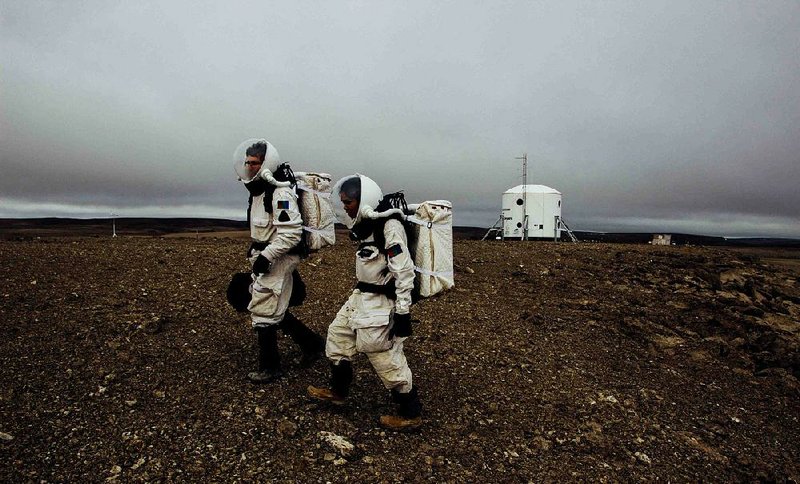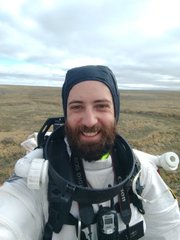FAYETTEVILLE -- Paul Knightly, a doctoral student at the University of Arkansas, Fayetteville, knows how the story of Mars will be told: through its rocks.
Already, a few details have been sketched out through images and other data transmitted by spacecraft and what NASA calls "robot geologists" on the planet's surface. But many questions, like whether Mars ever hosted life -- or if microorganisms exist there now -- remain unanswered.
"Everything that we can learn about Mars is going to be in the geologic record," Knightly said.
This summer, Knightly, 28, worked as a geologist on an Arctic science mission to simulate conditions that might be experienced should a crew travel to Mars.
Click here for larger versions
Photos courtesy University of Arkansas, Fayetteville doctoral student Paul Knightly
Photos courtesy University of Arkansas, Fayetteville doctoral student Paul Knightly
He lived and worked with five others in a cramped research station built in the late 1990s by the nonprofit Mars Society, an organization founded to boost public support for sending people to explore Mars.
Knightly said he hopes to someday be on such a crew. In Fayetteville, speaking six days after returning from Canada, he said it wasn't easy to readjust after living and working in a remote area.
"Knowing that you're cut off from everything is really humbling," Knightly said.
The research simulation began in mid-July after the crew's arrival was delayed because of weather and melting snow that made flights to the station impossible, said Shannon Rupert with the Mars Society.
Rupert oversees a Utah research station. She was not part of the crew in the Arctic but served as the main research investigator for the most recent project and an earlier, related mission in the Utah desert.
After weeks of waiting, the crew traveled by plane from Resolute Bay, an Inuit settlement in Canada, to the uninhabited Devon Island, home of the Mars Society's Flashline Mars Arctic Research Station. The crew's final report was dated Aug. 16.
It's an example of what's known as analog research, Knightly said.
"You go to a field site that has similarities to something you might see on Mars," said Knightly, the only American on the crew.
Rupert said the Arctic station was built in the late 1990s, placed on an impact crater left behind when a meteor hit Earth long ago.
Mars is pocked with similar craters, Rupert said, and the Arctic cold helps simulate the frigid conditions of a planet described by NASA as having an average temperature of 81 degrees below zero.
The station that housed the crew was purposely built small. Space travel will impose size limitations on any housing for the first crew to Mars, Rupert said. The round, two-level station on Devon Island has a diameter of 30 feet, she said.
Knightly said the crew also had to adapt to the lack of darkness, as daylight extended throughout their time at the station.
A generator provided electricity, and the crew used all-terrain vehicles to fetch water from a stream a bit less than a half-mile away, Knightly said.
Tracking water usage was part of the research, Knightly said, as any Mars crew likely would be very "water tight," perhaps limited by whatever water carried from Earth.
"How much do you actually need to cook? How much do you need to keep up with basic hygiene?" Knightly said, describing how the crew's experience helps answer those questions. Showers were limited to once a week, he said.
The crew members' mission required them to wear spacesuits and helmets while conducting field research, as Knightly studied the terrain and gathered data that he said should help him as he works toward a doctorate from UA.
Rupert said the science done by the crew has yet to be fully analyzed.
The mission, initially conceived as a yearlong simulation, also served as "a training facility for those people who want to be involved in human missions to Mars, either as crew, as mission support or as scientists here on earth," she said.
Knightly was chosen out of about 500 applicants, Rupert said, and his leadership skills made him the mission's first choice to be a commander for simulations that took place both in Utah and the Arctic.
Originally from Kansas City, Mo., Knightly said his interest in space exploration goes back to a sixth-grade rocketry project.
He applied to the Mars Society in 2013 as a recent graduate of Wichita State University.
"Being fresh out of school, I didn't really have any other commitments. I said, 'Hey, why not?'" Knightly said.
But while he advanced through the selection process, he pulled out of the crew to begin graduate studies at UA.
"It was a really hard call," said Knightly, who missed the portion of the research project based in the Utah desert.
Given a second chance to join the Arctic mission, Knightly stepped in after talking things over with his wife, Jessica, whom he had not met at the time he applied to the Mars Society.
"It was a mutual decision, and she said, 'No, you need to go and do this, you'll regret it if you didn't,'" Knightly said.
As a UA graduate student, Knightly studies a type of landform near glacial areas known as "patterned ground," natural features of the earth's surface that stand out because of their bubblelike, repeating shapes. Similar patterns also have been seen on Mars, Knightly said.
"The exact mechanics of it are still unknown," Knightly said, with the link to Mars only recently discovered.
"On Mars, we actually didn't know these existed until the last 15 or 20 years, once we actually had cameras around Mars that were powerful enough to resolve that," Knightly said.
Rupert, 57, said she believes a human crew will travel to Mars in her lifetime.
A NASA spokesman, Jim Wilson, said in an email that a 2019 flight test is scheduled for the spacecraft and rocketry expected in the next decade to ferry astronauts to missions beyond the moon.
Asked about Mars, Wilson said, "We're currently working toward a goal of a crewed orbital mission in the early 2030s, with landings to follow."
Wilson said that while NASA has "no large-scale formal collaboration" with the Mars Society, "we welcome their enthusiasm and participation" in the process of building support for Mars exploration.
Rupert said an understanding of Mars would be greatly helped by the arrival of scientists to the planet, even with mechanical rovers on the planet having gathered some information.
"A geologist on Mars in a week could do as much geology as the rovers have done," Rupert said, describing human scientists as "just much, much more efficient."
Knightly said he plans eventually to apply to join NASA's astronaut program, though the odds are long for all candidates.
In June, NASA announced 12 men and women chosen for the program out of more than 18,300 applicants.
Just days after his experience in the Arctic, Knightly said he needed more time to sort out how he'll ultimately remember the Devon Island experience.
"It was a combination of the landscape and just the beauty of it," he said.
Metro on 09/03/2017

